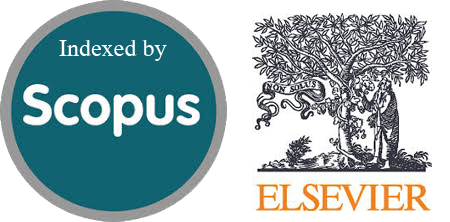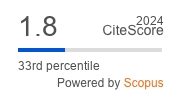Sentiment Analysis of Twitter Users to the PeduliLindungi Using Naïve Bayes Algorithm
Abstract
Covid-19 was declared as a pandemic by World Health Organization (WHO) in March 2020, has a major impact on the lives. Indonesian’s government has made several efforts to suppress the spread of the virus by requiring the societies to use PeduliLindungi in every activity. There are many pros and cons from the societies in using PeduliLindungi, many reviews about the performance of this application found through playstore, app store or social media. Twitter is one of social media that allows the societies to express their feeling, idea, opinion, or critics about any topics. This study takes the review of PeduliLindungi from Twitter with period from June up to December 2021, which has the highest cases of covid-19 and tighter movement restriction from the government. The data collected were manually labeling into positive and negative class and processed using sentiment analysis with Naïve Bayes algorithm, give the result 64.69% positive sentiment and 35.5% negative sentiment regarding PeduliLindungi. The model tested using Naïve Bayes algorithm with 10-fold cross validation has the highest performance, the accuracy obtained is 95.86%, with precision 96.99% and recall 94.12%. The positive sentiment indicates the pro expression from society, like the data integration with vaccine certificate, PCR or antigen result, that makes the activities to entry public transport or public space easily. The negative sentiment indicates the cons expression from the societies, related with the performance of the application and the data security. The result of this study expected being reference, give insight, and information for developers and governments to build a better strategy in improving the performance of PeduliLindungi application.
Downloads
References
S. Ekström et al., “General Stress Among Young Adults with Asthma During the COVID-19 Pandemic,” J. Allergy Clin. Immunol. Pract., vol. 10, no. 1, pp. 108–115, 2022, doi: 10.1016/j.jaip.2021.10.069.
R. Chatterjee, S. Bajwa, D. Dwivedi, R. Kanji, M. Ahammed, and R. Shaw, “COVID-19 Risk Assessment Tool: Dual application of risk communication and risk governance,” Prog. Disaster Sci., vol. 7, p. 100109, 2020, doi: 10.1016/j.pdisas.2020.100109.
E. Bilgic and Y. Duan, “E-commerce and Business Analytics: A Literature Review BT - Digital Economy. Emerging Technologies and Business Innovation,” 2019, pp. 173–182.
Z. Rais, F. T. T. Hakiki, and R. Aprianti, “Sentiment Analysis of Peduli Lindungi Application Using the Naive Bayes Method,” SAINSMAT J. Appl. Sci. Math. Its Educ., vol. 11, no. 1, pp. 23–29, 2022, doi: 10.35877/sainsmat794.
W. He, S. Zha, and L. Li, “Social media competitive analysis and text mining: A case study in the pizza industry,” Int. J. Inf. Manage., vol. 33, no. 3, pp. 464–472, 2013, doi: 10.1016/j.ijinfomgt.2013.01.001.
Samsir, Kusmanto, Abdul Hakim Dalimunthe, Rahmad Aditiya, and Ronal Watrianthos, “Implementation Naïve Bayes Classification for Sentiment Analysis on Internet Movie Database,” Building of Informatics, Technology and Science (BITS), vol. 4, no. 1, pp. 1–6, Jun. 2022.
A. Sarker et al., “Data and systems for medication-related text classification and concept normalization from Twitter: Insights from the Social Media Mining for Health (SMM4H)-2017 shared task,” J. Am. Med. Informatics Assoc., vol. 25, no. 10, pp. 1274–1283, 2018, doi: 10.1093/jamia/ocy114.
A. Jurek, M. D. Mulvenna, and Y. Bi, “Improved lexicon-based sentiment analysis for social media analytics,” Secur. Inform., vol. 4, no. 1, 2015, doi: 10.1186/s13388-015-0024-x.
R. Talib, M. Kashif, S. Ayesha, and F. Fatima, “Text Mining: Techniques, Applications and Issues,” Int. J. Adv. Comput. Sci. Appl., vol. 7, no. 11, pp. 414–419, 2016, doi: 10.14569/ijacsa.2016.071153.
H. S. Batubara, Ambiyar, Syahril, Fadhilah, and R. Watrianthos, “Sentiment Analysis of Face-To-Face Learning Based on Social Media,” Jurnal Pendidikan Teknologi Kejuruan, vol. 4, no. 3, pp. 102–106, 2021.
J. E. C. Saire and A. Pineda-Briseno, “Analysis of Covid-19 Impact in Mexico City using Text Mining and Twitter,” Proc. - 2020 Int. Conf. Digit. Transform. Innov. Technol. INCODTRIN 2020, pp. 33–37, 2020, doi: 10.1109/Incodtrin51881.2020.00018.
M. Birjali, M. Kasri, and A. Beni-Hssane, “A comprehensive survey on sentiment analysis: Approaches, challenges and trends,” Knowledge-Based Syst., vol. 226, p. 107134, 2021, doi: 10.1016/j.knosys.2021.107134.
S. U. Hassan et al., “Predicting literature’s early impact with sentiment analysis in Twitter,” Knowledge-Based Syst., vol. 192, p. 105383, 2020, doi: 10.1016/j.knosys.2019.105383.
R. Watrianthos, M. Giatman, W. Simatupang, R. Syafriyeti, and N. K. Daulay, “Analisis Sentimen Pembelajaran Campuran Pada Twitter Data Menggunakan Algoritma Naïve Bayes,” Analisis Sentimen Pembelajaran Campuran Pada Twitter Data Menggunakan Algoritma Naïve Bayes, vol. 6, no. 1, pp. 166–170, 2022, doi: http://dx.doi.org/10.30865/mib.v6i1.3383.
H. Parveen and S. Pandey, “Sentiment analysis on Twitter Data-set using Naive Bayes algorithm,” Proc. 2016 2nd Int. Conf. Appl. Theor. Comput. Commun. Technol. iCATccT 2016, pp. 416–419, 2017, doi: 10.1109/ICATCCT.2016.7912034.
M. Abbas, K. Ali, A. Jamali, K. Ali Memon, and A. Aleem Jamali, “Multinomial Naive Bayes Classification Model for Sentiment Analysis Overview of China View project Classification for Sentiment Analysis View project Multinomial Naive Bayes Classification Model for Sentiment Analysis,” IJCSNS Int. J. Comput. Sci. Netw. Secur., vol. 19, no. 3, p. 62, 2019, doi: 10.13140/RG.2.2.30021.40169.
B. Seref and E. Bostanci, “Sentiment Analysis using Naive Bayes and Complement Naive Bayes Classifier Algorithms on Hadoop Framework,” ISMSIT 2018 - 2nd Int. Symp. Multidiscip. Stud. Innov. Technol. Proc., 2018, doi: 10.1109/ISMSIT.2018.8567243.
F. S. Fitri, M. N. S. Si, and C. Setianingsih, “Sentiment analysis on the level of customer satisfaction to data cellular services using the naive bayes classifier algorithm,” Proc. - 2018 IEEE Int. Conf. Internet Things Intell. Syst. IOTAIS 2018, pp. 201–206, 2019, doi: 10.1109/IOTAIS.2018.8600870.
R. Riyanto, “Application of the Vector Machine Support Method in Twitter Social Media Sentiment Analysis Regarding the Covid-19 Vaccine Issue in Indonesia,” J. Appl. Data Sci., vol. 2, no. 3, pp. 102–108, 2021, doi: 10.47738/jads.v2i3.40.
M. Fahmi, Y. Yuningsih, and A. Puspita, “View of Sentiment Analysis Of Online Gojek Transportation Services On Twitter Using The Naïve Bayes Method.pdf,” J. Ilmu Pengetah. dan Teknol. Komput., vol. Vol.8 No.2, no. February 2023, 2023, doi: https://doi.org/10.33480/jitk.v8i2.4004.
M. Vadivukarassi, N. Puviarasan, and P. Aruna, “Sentimental Analysis of Tweets Using Naive Bayes Algorithm,” World Appl. Sci. J., vol. 35, no. 1, pp. 54–59, 2017, doi: 10.5829/idosi.wasj.2017.54.59.
H. Krishnan, M. S. Elayidom, and T. Santhanakrishnan, “Emotion Detection of Tweets using Naïve Bayes Classifier,” Int. J. Eng. Technol. Sci. Res., vol. 4, no. 11, pp. 457–462, 2017.
M. R. A. Nasution and M. Hayaty, “Perbandingan Akurasi dan Waktu Proses Algoritma K-NN dan SVM dalam Analisis Sentimen Twitter,” J. Inform., vol. 6, no. 2, pp. 226–235, 2019, doi: 10.31311/ji.v6i2.5129.
D. E. Cahyani and A. W. Putra, “Relevance Classification of Trending Topic and Twitter Content Using Support Vector Machine,” Proc. - 2021 Int. Semin. Appl. Technol. Inf. Commun. IT Oppor. Creat. Digit. Innov. Commun. within Glob. Pandemic, iSemantic 2021, pp. 87–90, 2021, doi: 10.1109/iSemantic52711.2021.9573243.
D. Berrar, “Cross-validation,” Encycl. Bioinforma. Comput. Biol. ABC Bioinforma., vol. 1–3, no. January 2018, pp. 542–545, 2018, doi: 10.1016/B978-0-12-809633-8.20349-X.
R. K. Saroj, P. K. Yadav, R. Singh, and O. N. Chilyabanyama, “Machine Learning Algorithms for understanding the determinants of under-five Mortality,” BioData Min., vol. 15, no. 1, pp. 1–23, 2022, doi: 10.1186/s13040-022-00308-8.
Copyright (c) 2023 Jurnal RESTI (Rekayasa Sistem dan Teknologi Informasi)

This work is licensed under a Creative Commons Attribution 4.0 International License.
Copyright in each article belongs to the author
- The author acknowledges that the RESTI Journal (System Engineering and Information Technology) is the first publisher to publish with a license Creative Commons Attribution 4.0 International License.
- Authors can enter writing separately, arrange the non-exclusive distribution of manuscripts that have been published in this journal into other versions (eg sent to the author's institutional repository, publication in a book, etc.), by acknowledging that the manuscript has been published for the first time in the RESTI (Rekayasa Sistem dan Teknologi Informasi) journal ;








